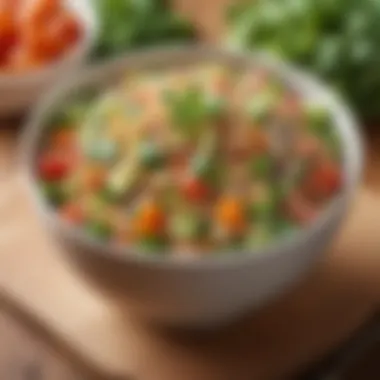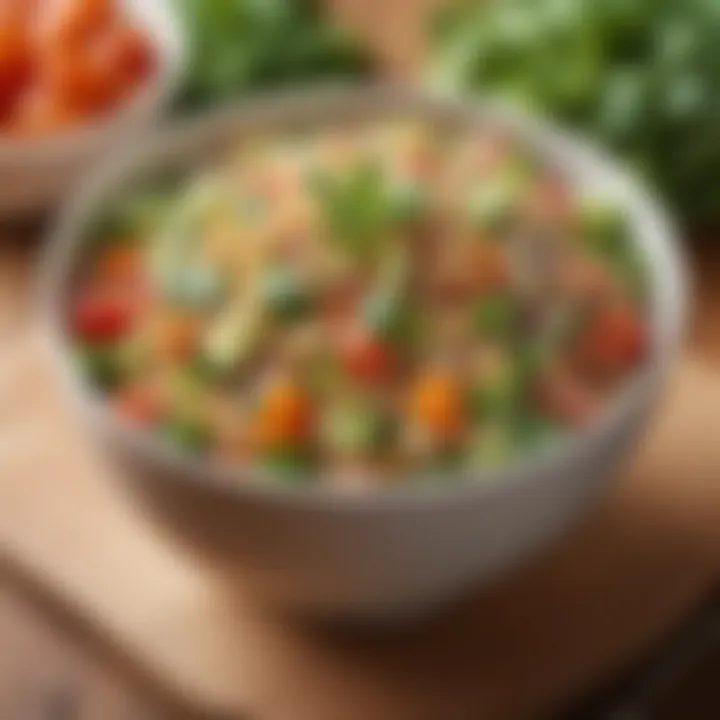Delicious Vegan Dinners to Aid Weight Loss


Intro
In today's health-conscious society, the pursuit of effective weight loss strategies has led many to explore vegan diets. Such diets not only promote health but also bring attention to ethical and environmental concerns. This article discusses various vegan dinner options designed to assist in weight loss while being satisfying and nutritious. We will highlight unique recipes, categorize meals based on flavor profiles and ingredients, and suggest practical preparation methods. Additionally, we aim to address some common challenges people face when shifting to vegan diets and emphasize the importance of a balanced nutrient intake for accomplishing weight loss goals.
Understanding Veganism and Weight Loss
Understanding the relationship between veganism and weight loss is essential for those exploring plant-based diets. As more individuals become health-conscious, the demand for effective weight management techniques rises. A vegan diet, which excludes all animal products, offers an avenue for weight loss due to its typically lower caloric density and higher fiber content. This section aims to clarify these concepts while emphasizing the benefits of adopting a vegan lifestyle for both weight loss and overall well-being.
The Concept of Veganism
Veganism is not just a diet; it is a lifestyle choice that seeks to eliminate exploitation and cruelty to animals. This philosophy extends beyond food to areas such as clothing and personal care products. The primary goal is to sustain a diet only comprising plant-based foods. Foods such as fruits, vegetables, grains, nuts, and seeds form the core of this lifestyle. As a result, a vegan diet can lead to increased intake of nutritious foods while minimizing the consumption of unhealthy fats.
Adopting veganism goes beyond just food choices. It involves a commitment to ethical considerations regarding animal welfare and environmental sustainability. By understanding this framework, individuals can appreciate the broader implications of choosing a vegan path.
Weight Loss Principles
Weight loss fundamentally relies on the principle of caloric deficit, achieved by consuming fewer calories than expended. The vegan diet can assist in accomplishing this goal effectively. Plant-based foods generally have lower caloric content compared to animal products, allowing for more substantial portions without exceeding caloric needs.
In addition to caloric considerations, the composition of a vegan diet plays a pivotal role in weight management. Foods rich in fiber, like legumes, whole grains, and vegetables, promote satiety, ensuring one feels full longer. Proteins also help in maintaining muscle mass during weight loss. Incorporating adequate amino acids from sources like quinoa, chickpeas, and soy products can optimize this effect.
Moreover, the elimination of highly processed foods rich in sugar and unhealthy fats often present in non-vegan diets can lead to positive health outcomes, supporting long-term weight management.
Nutritional Benefits of Vegan Diets
The nutritional profile of vegan diets presents various advantages for those aiming for weight reduction. A well-planned vegan diet can provide all essential vitamins and minerals. Notably, vitamins like C, E, and various antioxidants are abundant in plant foods, aiding in overall health.
Key nutrients like iron and calcium, typically associated with animal products, can be sourced from plants. Foods such as lentils, spinach, tofu, and fortified plant milks ensure adequate intake. Additionally, plant-based diets are often rich in healthy fats, particularly from nuts and seeds, which are crucial for hormone regulation and optimal body function.
The following points illustrate the benefits of a vegan diet:
- Lower risk of chronic diseases such as heart disease and diabetes.
- Improved digestion owing to increased fiber intake.
- Better weight control through healthier food choices.
Adopting veganism for weight loss is not simply about reducing calories. It involves embracing a variety of plant-based foods that nourish the body.
"A plant-based diet can be more than a method of weight loss; it is a channel toward sustainable living and ethical eating."
By understanding veganism and weight loss dynamics, one can effectively tap into the health benefits and manage weight through informed decisions. This foundational knowledge sets the stage for exploring specific ingredients and meal ideas that will further aid in achieving weight loss goals.
Key Ingredients for Vegan Dinners
Understanding the key ingredients for vegan dinners is essential for creating meals that not only promote weight loss but also deliver vital nutrients. The emphasis on whole foods helps ensure that the meals are rich in fiber, vitamins, and minerals while still being low in calories. Incorporating a variety of ingredients ensures meals are satisfying and flavorful. Here, we will explore four vital categories of ingredients that form the backbone of any vegan dinner plan: legumes and pulses, whole grains, vegetables and fruits, and nuts and seeds.
Legumes and Pulses
Legumes and pulses are a fundamental part of a vegan diet due to their high protein content and rich nutrient profile. Foods like lentils, chickpeas, and black beans are packed with protein, offering plant-based alternatives to meat. They also provide fiber, which is critical for digestive health and maintaining satiety during meals. Including these ingredients can help manage weight by keeping hunger at bay.
Additionally, legumes are versatile and can be used in various dishes, from soups to salads. For instance, you might consider preparing a hearty lentil stew or a chickpea salad with fresh veggies. Both options are filling and can easily be adjusted to suit personal tastes or seasonal ingredients.
Whole Grains
Whole grains contribute essential carbohydrates to the diet, providing energy while promoting overall health. Quinoa, brown rice, and farro are excellent examples. These grains contain more nutrients than their refined counterparts, including more fiber, vitamins, and minerals.
Incorporating whole grains into meals aids in stabilizing blood sugar levels, which supports moderate weight loss. They can be served as bases for bowls or salads, providing texture and flavor without excess calories. Including a mix of whole grains alongside legumes not only enhances the nutritional content but also adds variety to the dinner table.
Vegetables and Fruits
Vegetables and fruits are crucial in any plant-based dinner. They should make up a significant portion of the plate, offering a plethora of vitamins and minerals while being low in calories. Leafy greens like spinach and kale, as well as cruciferous vegetables like broccoli and cauliflower, are particularly nutrient-dense.
Eating a rainbow of fruits and vegetables ensures a wide range of nutrients. For example, combining sweet bell peppers, carrots, and dark leafy greens can create visually appealing and nutritious meals. Whereas fruits like avocados can add healthy fats and creaminess to dishes. Seasonal availability also allows for freshness and flavor variety.


Nuts and Seeds
Nuts and seeds should not be overlooked in a dinner plan. Foods like almonds, chia seeds, and walnuts provide healthy fats, protein, and essential nutrients. They can serve as toppings for salads or be integrated into dressings and main dishes, providing flavor and a satisfying crunch.
However, due to their higher calorie content, portion control is key when using nuts and seeds in meals. A small handful can go a long way in enhancing flavors without significantly increasing overall caloric intake.
Including a balance of these key ingredients not only supports weight loss but also fosters a well-rounded and enjoyable eating experience.
In summary, focusing on legumes, whole grains, vegetables, and nuts will set the stage for healthy, satisfying vegan dinners. Such meals can contribute to weight loss while meeting nutritional needs.
Delicious Vegan Dinner Ideas
In this article, the section on Delicious Vegan Dinner Ideas plays a crucial role in ensuring that individuals seeking to lose weight can still enjoy flavorful and satisfying meals. This section emphasizes the variety and richness of plant-based cooking, showcasing that healthy eating does not mean compromising on taste. Each recipe idea presented is designed to highlight nutritional value while also being satisfying, making it easier for people transitioning to veganism or looking to incorporate more plant-based meals into their diet.
The recipes in this section rely on whole, minimally processed ingredients that provide essential nutrients, supporting weight management and overall health. They focus not only on taste but also on the balance of macronutrients, ensuring that meal preparations are not only enjoyable but conducive to sustaining energy levels throughout the day. The exploration of creative vegan options can help combat the monotony associated with traditional diets while providing new culinary experiences.
Hearty Lentil Stews
Hearty lentil stews hold a prominent place in vegan dinners due to their high protein content and satisfying nature. Lentils are rich in fiber, which helps maintain fullness and supports digestive health. This section outlines two popular variations of lentil stew to cater to different dietary preferences.
Classic Lentil Soup
Classic Lentil Soup is a staple that many people gravitate toward. It is made using simple ingredients such as lentils, carrots, onions, and spices. This soup is a popular choice because it is not only affordable and easy to prepare but also versatile. You can add various vegetables according to availability or preference.
The unique feature of this soup lies in its comforting texture and ability to absorb flavors from herbs and spices. Additionally, it provides a significant amount of iron and protein, which are essential for anyone on a plant-based diet. However, its main disadvantage can be the time required for seasoning to develop fully, which may require some patience.
Spicy Lentil Curry
On the other hand, Spicy Lentil Curry brings a different profile to the table. This dish is infused with spices like turmeric, cumin, and chili powder which elevate its flavor significantly. It stays relevant in discussions about weight loss thanks to its hearty ingredients that warm and satisfy.
The key characteristic of Spicy Lentil Curry is the warmth and complexity of its spices, making it a popular dish among those who enjoy dynamic flavors. Its high fiber and protein content also contribute to feelings of satiety, helping individuals adhere to their weight-loss goals. One minor drawback is that it might be too spicy for some palates, which can lead to a lesser appeal among sensitive diners.
Savory Grain Bowls
Savory grain bowls provide another excellent approach to crafting a filling vegan dinner. They allow for creativity and customization, accommodating various tastes and dietary needs. In this section, we will explore two delectable options that embody this concept.
Quinoa and Roasted Vegetable Bowl
The Quinoa and Roasted Vegetable Bowl stands out for its light yet satisfying ingredients. Quinoa is a complete protein source and adds a nutty flavor that complements roasted vegetables like bell peppers, zucchini, and carrots. This bowl provides essential vitamins and minerals while maintaining a low-calorie profile.
What makes this dish particularly appealing is its colorful presentation, a crucial aspect when preparing meals to enhance enjoyment. However, the time required for roasting the veggies should be considered—delays might occur if meal prep is rushed.
Farro Salad with Chickpeas
In contrast, the Farro Salad with Chickpeas brings a chewy texture and earthy taste that many appreciate. Farro is ancient grain with a rich taste that combines well with protein-filled chickpeas. This dish can be served cold, which adds an element of convenience for meal preparation ahead of time.
Its unique selling point is the combination of flavors and textures that keep the dining experience lively while maintaining a full range of nutrients. The downside may include the longer cooking time for farro compared to other grains, which should be taken into account when planning for busy evenings.
Stuffed Vegetables
Stuffed vegetables represent a fantastic choice for dinner as they allow for inventive use of other leftovers, maximizing ingredient use. This section explores two popular varieties that are both filling and nutritious.
Stuffed Bell Peppers
Stuffed Bell Peppers delight with their vibrant colors and diverse fillings like brown rice, beans, and spices. This dish is well-loved for its adaptability to include different grains and proteins, making them a great choice in meal planning.
The key aspect here is the balance of textures; the crunch from the peppers contrasts nicely with the softness of the filling, which appeals to many diners. However, it's important to note that some may find them slightly bland without proper seasoning or spices, thus requiring attention during preparation.
Zucchini Boats


Next, Zucchini Boats offer another variation that is gaining popularity. They can be filled with a range of ingredients, including quinoa, black beans, and spices. This dish is particularly advantageous as zucchini is low in calories yet high in water content, contributing to a sense of fullness without excess calories.
The unique feature of Zucchini Boats is their fun presentation and customization options. On the flip side, if not cooked carefully, the zucchini can become too soft, making it unappealing to some diners.
Creative Stir-Frys
Stir-frys are practical dishes that can be prepared quickly, making them ideal for weeknight dinners. Their ability to highlight fresh ingredients while adding an array of flavors is what makes them a crucial component of any vegan meal plan.
Tofu Vegetable Stir-Fry
The Tofu Vegetable Stir-Fry is a perfect example of an easy, nutritious dinner. Tofu serves as a great source of protein and absorbs flavors well, allowing for varying taste profiles. It is widely considered a beneficial choice because of its high protein content, playing an essential role in muscle repair and satiety.
A significant aspect of this dish is its speed of preparation, allowing for healthy eating even on the busiest days. However, the challenge arises from properly cooking tofu, as it can easily become rubbery if overcooked.
Chickpea and Broccoli Stir-Fry
Meanwhile, Chickpea and Broccoli Stir-Fry emphasize texture and balance. Broccoli provides a satisfying crunch, while chickpeas add protein and fiber, making it another fantastic weight loss meal. This option is particularly noted for its quick preparation time and ease of cooking.
Its unique feature is the combination of the flavors enhanced by a quick stir-frying method, which maintains the nutrients from the vegetables. However, there can be concerns about overcooking broccoli, which can lead to a less appealing texture and loss of nutrients if not monitored closely.
Nutrient-Rich Salads
Salads play a fundamental role in vegan diets, providing fresh tastes and a variety of textures that can greatly aid in weight management. In this section, we explore two prominent salad options that contribute significantly to nutritional intake.
Spinach and Avocado Salad
The Spinach and Avocado Salad is a vibrant and nutrient-dense dish. Spinach is rich in iron and fiber, while avocados provide healthy fats that keep one feeling full for longer. This salad is a favored choice because it is not only quick to prepare but also packs a significant amount of vitamins.
Its unique aspect lies in its creamy texture paired with the light crunch of spinach. It is essential to note, however, that overloading on avocado can lead to excess calorie intake. Balancing portions is key.
Chickpea Salad with Lemon Dressing
Lastly, the Chickpea Salad with Lemon Dressing offers a refreshing and zesty option. Chickpeas bring protein and fiber into the mix while the lemon dressing adds a brightness that elevates the flavor profile. This dish is popular for meal prepping due to its longevity in the fridge and ease of assembly.
What makes this salad particularly beneficial is its simplicity and ease of modification. The primary drawback could be that taste preferences vary, as not everyone may enjoy a tangy lemon dressing.
Meal Planning for Success
Meal planning is a cornerstone of successful weight loss, especially within a vegan framework. A well-thought-out meal plan not only aids in calorie control but also ensures that you receive adequate nutrients. Such planning reduces the likelihood of impulsive, unhealthy eating choices and streamlines grocery shopping and food preparation.
The act of planning meals holds several benefits. It saves time and effort during busy weeks, ensuring that your dinners align with your weight loss goals. Additionally, it can save money by minimizing food waste. The importance of meal planning becomes markedly clear for individuals seeking a structured approach to a vegan lifestyle.
Creating a Balanced Menu
A balanced menu for vegan meals considers protein, carbohydrates, and healthy fats. Focus on incorporating legumes like lentils, black beans, and chickpeas. These provide essential amino acids, promoting sustained energy and fullness.
Here are tips to create a balanced menu:
- Diverse Ingredients: Mix different sources of food. Think whole grains, vegetables, and fruits. This variety ensures that you receive a wide range of nutrients.
- Monitor Portions: Keep an eye on portion sizes. Using measuring cups can help, especially for high-calorie items like nuts or oils.
- Colorful Plates: Include various colors on your plate. Different colors often indicate different nutrients. This approach adds visual appeal and nutritional benefits.
Batch Cooking and Preparation
Batch cooking is a practical method that saves time and effort throughout the week. By dedicating a couple of hours on the weekend or during a less busy day, you can prepare multiple meals in advance. This technique is especially useful for vegan dinners where many dishes can be stored and reheated.
- Cook in Bulk: Prepare large quantities of grains like quinoa or brown rice. Also, cook several portions of lentils or beans. They can be easily mixed with vegetables for quick meals.
- Store Effectively: Invest in good quality containers for freezing or refrigerating meals. Clearly label containers with contents and dates for easy access.
- Make Use of Freezer: A well-stocked freezer can be a lifesaver. Consider freezing soups, stews, and prepared grain bowls. They maintain nutritional value while offering convenience.
Ingredient Substitutions
Adapting recipes with ingredient substitutions can enhance nutritional balance and cater to personal preferences. For instance, if a dinner recipe calls for traditional flour, consider almond or chickpea flour instead for added protein.


Here are some common substitutions to consider:
- Dairy Alternatives: Use almond milk or coconut yogurt in place of regular dairy products.
- Egg Replacements: For binding, use chia seeds mixed with water or mashed bananas.
- Protein Choices: Instead of meat, focus on seitan or tempeh. These provide a similar texture while supporting a plant-based diet.
"Ingredient substitutions not only enhance the nutritional value of a dish but also allow for creativity in cooking."
This strategic approach to meal planning facilitates a healthier lifestyle while aiding in weight loss. It accommodates various preferences and encourages a wholesome relationship with food.
Challenges in a Vegan Diet
When embarking on a vegan diet, individuals face unique challenges that can impact their journey toward weight loss and health. Understanding these challenges is crucial as it prepares individuals to navigate their new eating habits without compromise. Emphasizing the importance of nutritional balance, overcoming cravings, and managing time effectively can lead to a more successful transition and a sustainable vegan lifestyle.
Maintaining Nutritional Balance
Achieving a nutritional balance on a vegan diet is essential. Unlike omnivorous diets, vegans must carefully curate their food selections to ensure they receive adequate nutrients. Common deficiencies include protein, vitamin B12, calcium, iron, and omega-3 fatty acids.
To address these deficiencies:
- Incorporate diverse sources of protein such as legumes, nuts, and tofu.
- Use fortified plant-based milk or take supplements for vitamin B12.
- Include green leafy vegetables and fortified foods for calcium.
- Consume legumes and whole grains for iron absorption.
- Include chia seeds or flaxseeds for omega-3 fatty acids.
Being proactive in food choices helps individuals meet their nutritional needs while pursuing their weight loss goals.
Overcoming Cravings
Cravings often pose a significant hurdle in the pursuit of a successful vegan diet. It can be difficult to ignore the pull of comfort foods or familiar flavors. This challenge is compounded when transitioning from a diet high in processed foods to a more plant-centric approach.
To combat cravings:
- Keep healthy snacks, such as hummus with veggies or mixed nuts, readily available.
- Experiment with spices and herbs to build satisfying flavors in meals.
- Acknowledge cravings without guilt, and seek alternatives rather than suppression, like using avocado as a creamy addition instead of cheese.
Developing a mindful eating practice can help align an individual’s cravings with nutritional foods rather than succumbing to harmful choices that may derail weight loss efforts.
Time Management in Cooking
Time management is often overlooked but is a critical component for anyone considering a vegan lifestyle. Preparing plant-based meals can require more upfront planning compared to simply reheating processed meals. Juggling work, family, and social obligations can make adhering to a cooking schedule challenging.
To manage time effectively:
- Plan meals in advance and prepare a shopping list to avoid impulse purchases.
- Dedicate time on weekends for batch cooking, making it easier to access meals during the week.
- Use quick-cooking grains like quinoa and cook large batches to use throughout the week.
Efficient time management helps in achieving not just meal preparation but also ensures that a vegan diet can fit smoothly into a busy lifestyle. Overcoming these challenges is essential to harnessing the full potential of a vegan diet for weight loss and overall health.
Resources for Vegan Cooking
In the realm of vegan cooking, having access to high-quality resources is crucial for both beginners and seasoned chefs. These tools and platforms not only provide recipes but also foster an understanding of plant-based nutrition, cooking techniques, and ingredient substitutions. As one embarks on a journey toward healthier meals, the relevance of these resources cannot be overstated. They serve as a foundation that enhances culinary skills and supports sustainable dietary choices, ultimately aligning with weight loss objectives.
Cookbooks and Online Resources
Cookbooks tailored for vegan diets offer an abundance of recipes ranging from simple meals to complex dishes. These books are not just collections of recipes; they often provide insights about nutritional values, cooking methods, and lifestyle adjustments. Some noteworthy titles include Isa Does It by Isa Chandra Moskowitz and Plenty by Yotam Ottolenghi. Online resources, such as established websites like Minimalist Baker and Oh She Glows, further expand on these ideas, presenting a vast array of user-friendly recipes.
In addition to being informative, these resources facilitate exploration of various cuisines. This diversity in our cooking can help combat meal fatigue, keeping the dining experience fresh and exciting. The inclusion of seasonal produce and locally available ingredients is emphasized; this practice reinforces the connection between food choices and health, while also reducing environmental impact.
Cooking Classes and Workshops
Participating in cooking classes and workshops can greatly enhance one's culinary capabilities. These classes often offer hands-on experiences where individuals can learn the techniques fundamental to vegan cooking. Many community centers and culinary schools provide classes aimed at various skill levels, from novice cooks to those seeking advanced techniques.
Workshops typically focus on specific themes, such as meal prepping or international vegan cuisine. This concentrated focus allows for deeper engagement with particular ingredients or cooking methods, enriching the learner's knowledge. Moreover, the social aspect of cooking classes encourages bonding over shared interests, creating a supportive environment for exploring plant-based cooking.
Meal Kits and Delivery Services
For those who prefer convenience, meal kits and delivery services can be a fantastic aid in vegan cooking. Companies like Purple Carrot and Green Chef offer ready-to-cook meal kits, designed specifically for plant-based diets. These services take the guesswork out of shopping and planning by providing pre-measured ingredients and step-by-step instructions.
Using meal kits can also minimize food waste, as the exact amount of ingredients is delivered, reducing the likelihood of unused produce going to waste. Many services continuously update their menus to introduce seasonal ingredients and new recipes, ensuring a diverse range of meals.
Thus, adopting these resources for vegan cooking can dramatically improve the success of one's plant-based journey. By integrating cookbooks, attending workshops, and utilizing meal kits, anyone can elevate their cooking skills and contribute to their weight loss endeavors with delicious, healthy meals.







